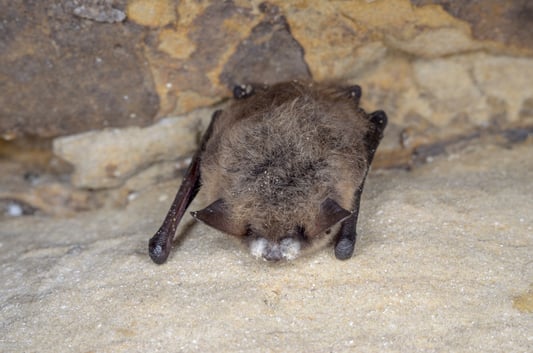Chiroptera, commonly known as bats, is the second most diverse mammalian order. These flying mammals present 1,232 species. Colorado hosts a considerably diverse array of bat species. Eighteen species of bats occupy Colorado year-round or pass through during migration. The Colorado Parks and Wildlife identify bats as one of the most mysterious land mammals.

Colorado bats face an infectious disease known as White Nose Syndrome (pictured above).
Colorado bats face several stressors: habitat loss, wind energy development, climate change, and white-nose syndrome (WNS). WNS is a fungal, infectious disease caused by Pseudogymnoascus destructans (Pd) that killed over 5.5 million hibernating bats in North America in 2006 when first detected in the United States. WNS infects bat muzzles, wing membranes, and pinnae and triggers arousal from hibernation more frequently than is typical. This causes bats to expend more energy and burn fat storage, leaving insufficient fat stores for hibernation, leading to high mortality in bat populations due to starvation. While WNS has been an issue facing the states east of the Mississippi River since 2006, Colorado and other western states have only recently been affected by WNS. In June 2022, the U.S. Geological Survey confirmed that Pd was found on a bat at Bent’s Old Fort National Historic Site in Otero County. WNS is now reported that both Larimer County and Otero County.
In 1998, the Colorado Committee of the Western Bat Working Group (CCWBWG) was established to guide “individuals, agencies, and other groups to facilitate the conservation and management of bats and their habitats in Colorado''. In 2004, the CCWBWG created a conservation plan for those who manage land in Colorado, those interested in bat conservation and research, and institutions responsible for managing natural resources in the state. The management plan aims to gain a more comprehensive knowledge of bat roosting in Colorado caves, including identifying, protecting, and restoring ecosystems and habitats critical to the viability of cave-associated bat populations.
Similarly, other research suggests that additional surveys over multiple seasons and years are needed to obtain a clear picture of how bats in Colorado use caves. Surveillance in locations with vulnerable species may lead to better detection rates of the fungus that causes WNS. In addition to identifying cave sites, implementing new techniques and equipment allows for less intrusive monitoring of bat colonies. For example, non-invasive sampling techniques, such as acoustic sampling, will help reduce interference with bat behavior.
As we have seen in the eastern United States since 2006, WNS is lethal to cave-dwelling bat species and populations. There is an action every person can take to help conserve bat species in Colorado. We can all continue to grow our knowledge and awareness of bats. Something as simple as educating ourselves on bats can help make a change.
Keaton Cloven is a First Year Foley Graduate Fellow at Walking Mountains Science Center. During undergrad, Keaton studied and wrote her thesis on Bat occupancy in Minnesota oak savanna forest habitats.







